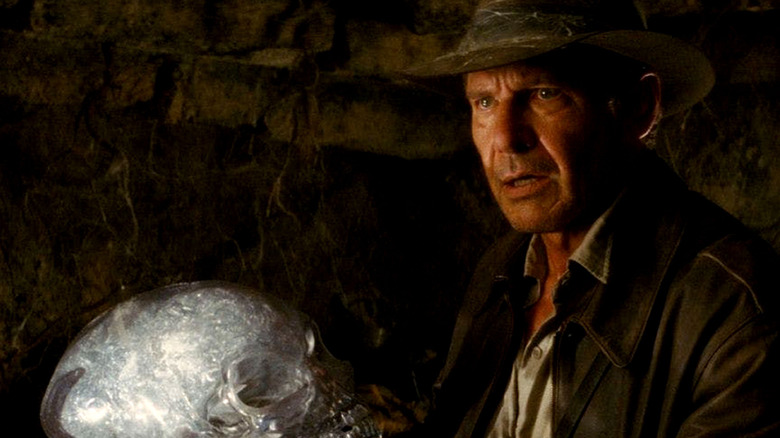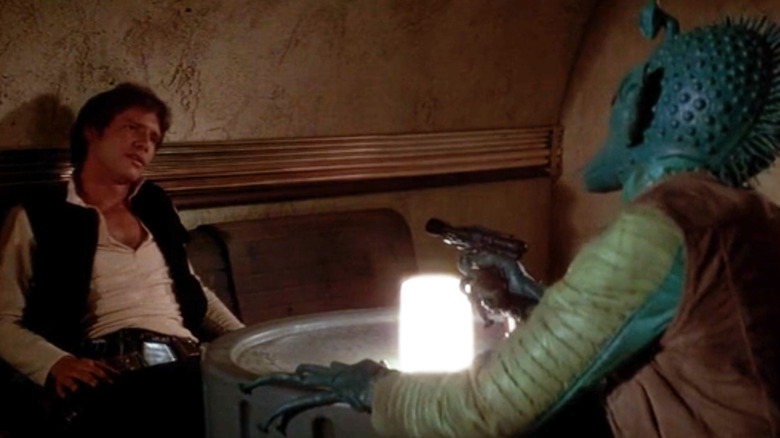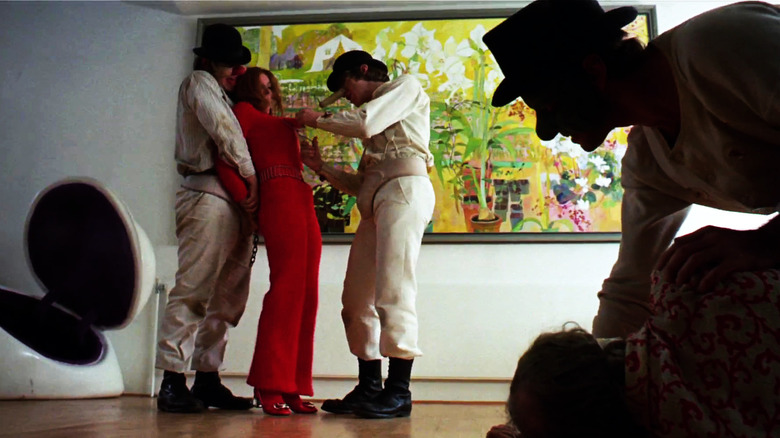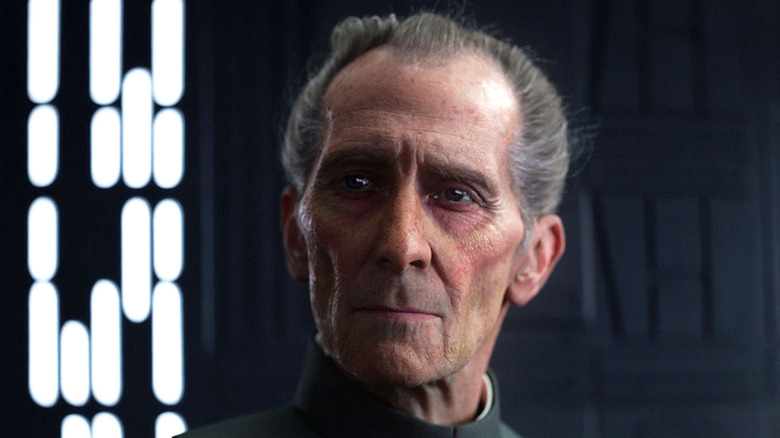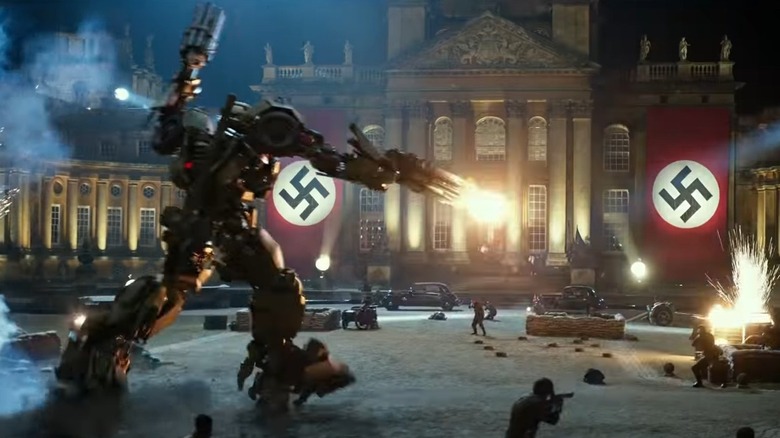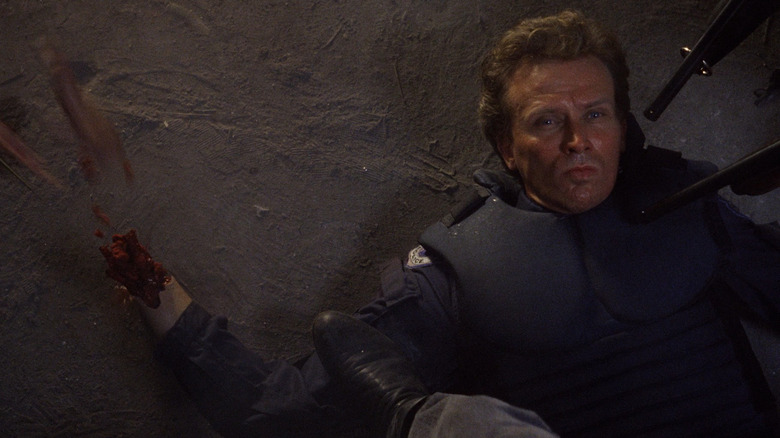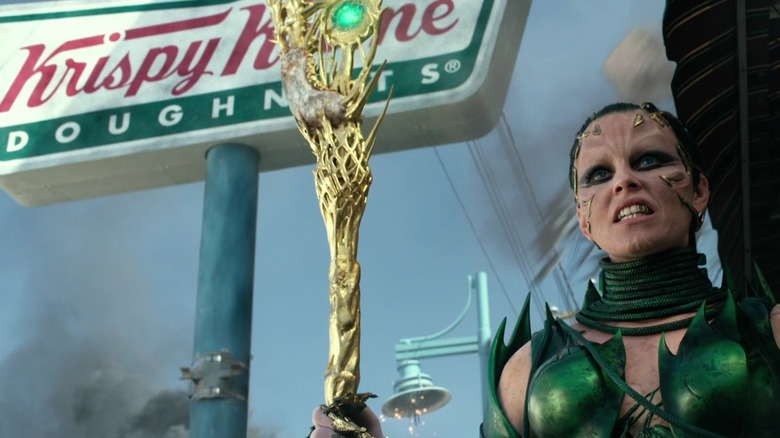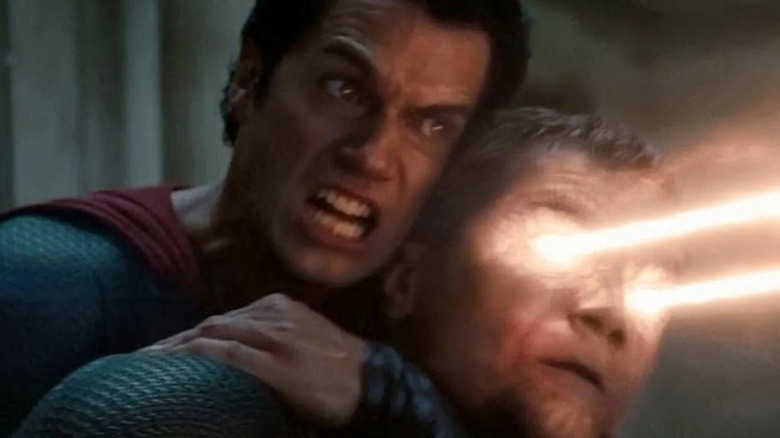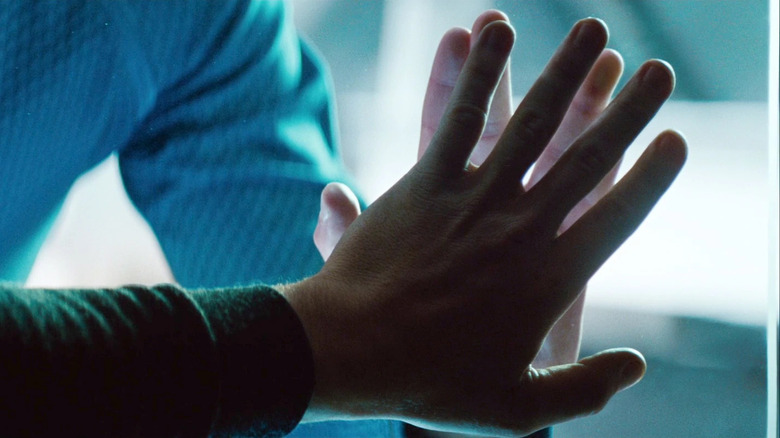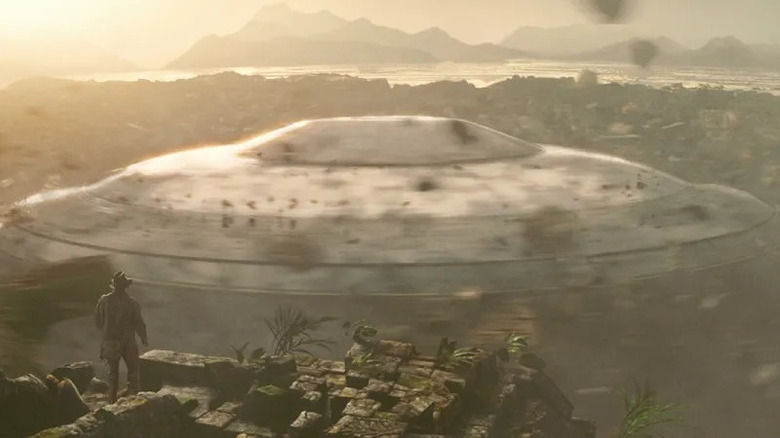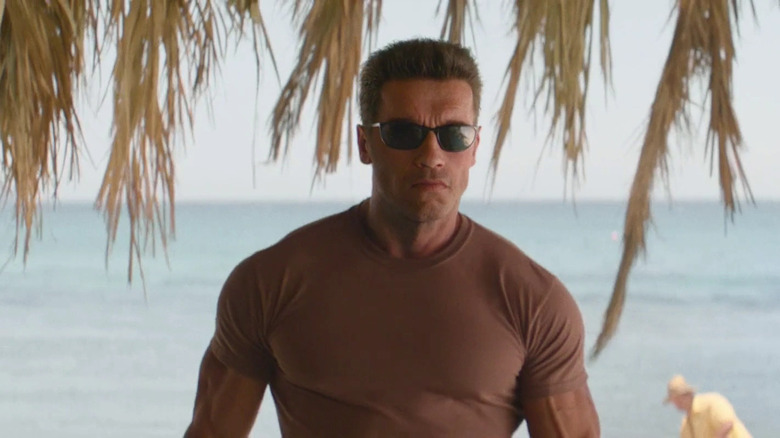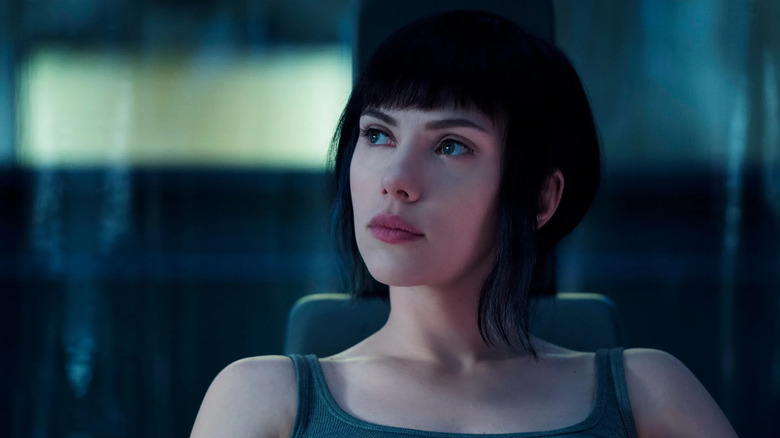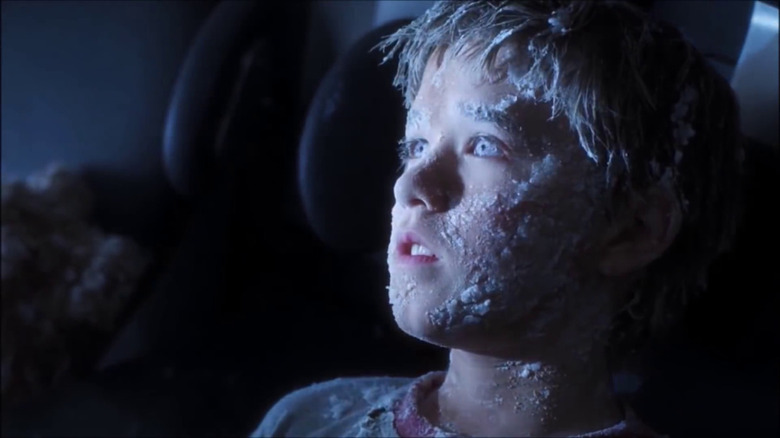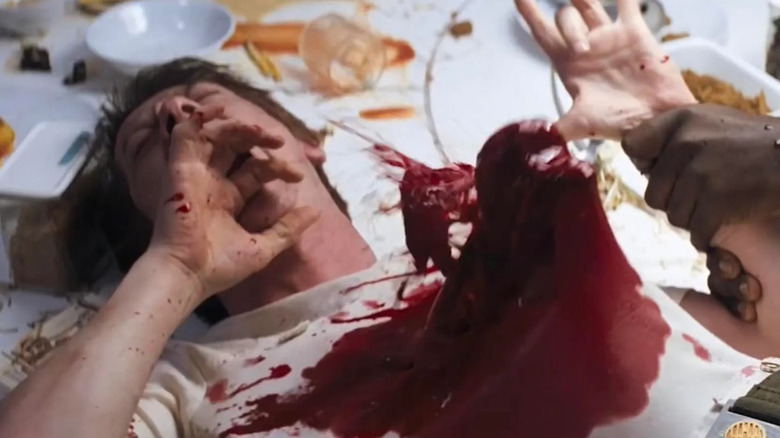The Most Controversial Scenes In Sci-Fi Movies
There is more opportunity than ever before to share your opinions about science fiction movies. Social review sites like IMDb and Letterboxd have made it easy for sci-fi movie buffs to write reviews and share them with their friends. It's always interesting if you can have a great discussion about a controversial movie, and share your opinions respectfully. You may even learn to look at a piece of work from someone else's perspective!
There are many reasons that a film is deemed "controversial." Sometimes a shocking or unsatisfying ending can rub viewers the wrong way, and a surprising death can definitely color fans' opinions of a movie. There are some science fiction films that were so incendiary that they were banned in different countries. The sci-fi genre has a history of stirring up controversy, and some sci-fi masterpieces were ahead of their time while other beloved favorites have suffered with age. Here are some of the most controversial scenes in sci-fi movies.
Han Shoots Greedo — Star Wars (1977)
In the original version of "Star Wars" released theatrically in 1977, Han Solo (Harrison Ford) shoots the bounty hunter Greedo (Paul Blake) in the Mos Eisley Cantina. When he was reworking the film many years later, director George Lucas felt like the scene turned Solo into a cold-blooded murderer. He didn't want audiences to have the wrong impression about the character, so he re-edited the scene for the 1997 "Special Edition" that was released in theaters. In the revised version, Greedo fires his weapon, and then Han kills him.
This sparked an outcry among viewers. It felt like Han wasn't as clever as he was originally. The debate got even messier with each subsequent re-release of the film, with the 2004 DVD release editing the scene so that both Han and Greedo fire their weapons at the same time. In the 2011 Blu-Ray version, both characters fire at the same time, but a few frames were removed. When the entire saga was made available on Disney+, Greedo makes a brief exclamation in the alien language Huttese before he dies. Lucas has continued to defend the scene amidst the controversy. In "The Star Wars Archives: 1999-2005," Lucas stated that he "never designed Han to be a ruthless killer" and that "all the good guys shoot in self-defense."
Home Invasion — A Clockwork Orange (1971)
Stanley Kubrick is no stranger to controversy, but "A Clockwork Orange" provoked strong reactions when it debuted in 1971. It was among the few films to receive an "X" rating that became a mainstream success, and one of the disturbing moments that earned that rating is a scene where the young criminal Alex DeLarge (Malcolm McDowell) and his gang break into a house. Alex assaults a woman while her husband is forced to watch. Critics who were disturbed by the film's graphic content zeroed in on the use of the classic song "Singin' in the Rain" as the most offensive aspect. Kubrick needed to show that Alex was beyond reason and that any attempts to curb his behavior would be doomed to fail.
The association of a song as beloved as "Singin' in the Rain" with disturbing events caused so much controversy that Kubrick asked Warner Brothers to remove the film from circulation in Britain. Gene Kelly, the star of the original "Singin' in the Rain," was also upset, but not for the reasons that you might think. McDowell revealed in an interview years later that Kelly hadn't been paid any royalties for use of the song. McDowell joked that "there's quite a gang of us who haven't been paid!"
CGI Peter Cushing — Rogue One: A Star Wars Story (2016)
"Rogue One: A Star Wars Story" used digital de-aging techniques to bring back the character Grand Moff Tarkin (Peter Cushing). While other films have used computer-generated imagery to restore an actor's younger likeness, Cushing passed away in 1994 at the age of 81. Lucasfilm controversially used archive footage to resurrect Cushing's face and insert it onto the actor Guy Henry.
The ethics of this technique started a fiery debate: It was one thing for Samuel L. Jackson to play a younger version of Nick Fury in "Captain Marvel," but it was a different thing entirely to use a deceased actor's likeness. Lucasfilm was forced to respond to the arguments that were raised in an official statement, while producer Kiri Hart posited that if the character is "not in the movie, we're going to have to explain why he's not in the movie." "Rogue One" leads directly into the events of "A New Hope," so Tarkin's image had to be kept identical to retain the continuity. That being said, it's arguable that continuity should not come at the cost of morality. The effect is distracting and slightly unnerving, and it felt especially odd for Henry's voice to be coming out of Cushing's body. Even if Lucasfilm did consult with Cushing's estate over the issue, the film set a dangerous precedent that could easily be taken advantage of.
World War II Sequence — Transformers: The Last Knight (2017)
It was established in the first "Transformers" movie that Autobots and Decepticons had been on Earth for a long time. "Transformers: Revenge of the Fallen" tied the story into the creation of the Great Pyramids, "Transformers: Dark of the Moon" included a scene using the "Apollo 11" mission, and "Transformers: Age of Extinction" blamed the extinction of the dinosaurs on a robotic culprit.
"Transformers: The Last Knight" featured flashbacks to many different points in history, including World War II. Controversy emerged when set photos of Winston Churchill's home draped in Nazi flags were leaked. Some found the decoration of Churchill's residence with fascist material to be offensive. Tony Hayes of Veterans Association UK said that veterans of World War II "will be appalled by this." Director Michael Bay weighed in on the controversy, and said "people were not fortunate enough to read the script, and they don't know that Churchill in this movie is a big hero." While Churchill's estate has yet to comment on the quality of "The Last Knight," Churchill's grandson Nicholas Soames commented that the controversy was "preposterous." He felt that filmmakers should have the right to use a historical location for filming purposes. There are a lot of reasons why people should be upset with "Transformers: The Last Knight," but the use of a Nazi flag for historical context is not one of them.
Murphy's Death — Robocop (1987)
"Robocop" is one of the most shockingly violent action movies of the 1980s. Although the film features some incredibly graphic moments, it was originally even more gruesome. When director Paul Verhoeven submitted the film to the MPAA, it received an "X" rating typically used for films that were too graphic to be rated "R" before the invention of the NC-17 rating.
Verhoeven wanted to ensure that "Robocop" would be successful, so he was forced to trim down the film's content in order to receive an "R" rating upon resubmission. Several shots of Alex Murphy's (Peter Weller) death had to be removed. Verhoeven claimed that he had to submit the film eight different times before he walked away with an R rating. The edits seemed to do the trick, and "Robocop" became a hit, even managing to attract some younger viewers because of the toys that were released. However, "Robocop" fans who really want to see what Verhoeven originally had in mind are in luck. The original, uncut version of the film periodically appears on DVDs and streaming services, so keep an eye out. You should be able to see it ... eventually.
Krispy Kreme Product Placement — Power Rangers (2017)
Product placement is unfortunately just part of the filmmaking process. Sometimes, product placement can result in a truly magical moment, as in "E.T. the Extra-Terrestrial" when Elliot (Henry Thomas) shares some Reese's Pieces candy with his alien friend. However, there's a point where product placement becomes distracting within the context of the story when it feels like the film is stopping in its tracks to run an advertisement. Come on, those are supposed to be before the movie!
Case in point, the recent reboot of the "Power Rangers" franchise featured an excessive amount of product placement for Krispy Kreme doughnuts, reaching its peak in the third act where an entire action sequence is set around a Krispy Kreme location. Fans of the franchise were upset about the shallow nature of the marketing tactics. Prior to the film's release, Krispy Kreme revealed a new line of doughnuts as a promotional tie-in, and the movie makes it seem like every social function in Angel Grove revolves around Krispy Kreme.
Superman Murders Zod — Man of Steel (2013)
It would be an understatement to say that "Man of Steel" was a divisive film. Zack Snyder's dark, moody take on Superman (Henry Cavill) seemed to split DC fans down the middle. While some audiences appreciated the film's different perspective on the Kryptonian origin story, others criticized the violence, excessive religious symbolism, strange editing choices, and lack of emotion.
However, there was one moment from "Man of Steel" that sparked a huge debate among comic book fans. During the film's third act, Superman manages to corner General Zod (Michael Shannon) and get him into a headlock. Zod threatens to murder an innocent family, and Superman is forced to snap his neck. Would Superman kill? It's a question that inspired responses from various DC writers. "Man of Steel" screenwriter David S. Goyer defended the moment, and said that this version of Superman is "not aware of the extent of his powers." However, longtime DC Comics artist Neal Adams stated on Kevin Smith's Smodcast podcast that it was not consistent with the character and that Superman could have found an alternative solution. "Superman: Birthright" writer Mark Waid also expressed his disappointment, and claimed that Snyder had betrayed everything that was essential to the character by having him kill someone.
Kirk's Sacrifice — Star Trek Into Darkness (2013)
Prior to the release of "Star Trek Into Darkness," Paramount Pictures and Bad Robot hilariously tried to hide the fact that Benedict Cumberbatch was playing the character Khan Noonien Singh from 1982's "Star Trek II: The Wrath of Khan." Cumberbatch denied that he was playing Khan, and claimed that the new villain "John Harrison" was a completely original villain. He wasn't totally lying, as "John Harrison" is the false identity that Khan uses in order to infiltrate Starfleet.
The villain wasn't the only thing that "Star Trek Into Darkness" and "Star Trek II: The Wrath of Khan" had in common. During the emotional ending of "The Wrath of Khan," Spock (Leonard Nimoy) gives his life to save Captain James T. Kirk (William Shatner) and his friends. "Into Darkness" nearly replicates the scene, but reverses the roles. It's Kirk (Chris Pine) that gives his life, and Spock (Zachary Quinto) who is left to scream "Khan!" The parallels with "The Wrath of Khan" drew blowback from some "Star Trek" creators. "Into Darkness" writer Damon Lindelof said that he and his co-writers were "wary of the line between 'reimagined homage' and 'direct ripoff,'" but "The Wrath of Khan" director Nicholas Meyer didn't agree. In an interview with the "Midnight's Edge" podcast, Meyer said that he found the decision to recreate the scene to be artistically inappropriate and that there was no reason to remake the moment without adding something new to it.
Aliens — Indiana Jones and the Kingdom of the Crystal Skull (2008)
The "Indiana Jones" franchise isn't technically science fiction, is it? Well, it is now thanks to "Indiana Jones and the Kingdom of the Crystal Skull." A twist at the end of the fourth installment revealed that some ancient civilizations on Earth were created by alien visitors that some tribes worshiped as gods.
The decision to put aliens in an "Indiana Jones" movie is part of the reason that "Kingdom of the Crystal Skull" took so long to reach theaters. George Lucas felt that aliens were an essential part of the story, but Steven Spielberg and Harrison Ford thought that inserting science fiction elements into the franchise would be a mistake. According to J. W. Rinzler's "The Complete Making of Indiana Jones," the film went through several stages of development before Lucas, Spielberg, and Ford agreed on a final version of the script that incorporated aliens. It still inspired serious blowback. While some critics, such as Matt Zoller Seitz, admired the bravery of this move, many reviewers felt that the sci-fi twist ruined the franchise. Spielberg came to the film's defense and said that he wanted to remain loyal to Lucas. However, "Kingdom of the Crystal Skull" writer David Koepp admitted on the "Script Alert" podcast that the aliens were a "mistake."
John Connor's Death — Terminator: Dark Fate (2019)
The Terminator franchise has been in serious decline ever since 1991's "Terminator 2: Judgment Day." Without James Cameron at the helm, "Terminator 3: Rise of the Machines," "Terminator Salvation," and "Terminator Genisys" all failed to recapture the same magic of the first two films. "Terminator: Dark Fate" promised to do something different since the "legacy sequel" was bringing back James Cameron as story creator as well as Linda Hamilton as an older version of Sarah Connor.
Unfortunately for Terminator fans, "Dark Fate" managed to completely ruin its characterization of Sarah Connor within its opening scene. During a flashback to the year 1998, a T-800 Terminator (Arnold Schwarzenegger) ambushes Sarah and her son John (Edward Furlong) while they are on vacation. John is killed during the attack. Even though Sarah had trained to protect John for her entire life, she isn't able to save him. Understandably, this decision inspired a fiery response from fans of the series. A common criticism was that killing off John Connor didn't respect the entire point of the first two films. "Chicago Sun-Times" critic Richard Roeper felt that the "casual" way in which John is murdered was distasteful. Furlong even said that he was "bummed out" by John's fate.
Explanation For Whitewashing — Ghost in the Shell (2017)
The 2017 live-action remake of the anime "Ghost in the Shell" attracted significant controversy before it was even released. The decision to cast Scarlett Johansson as the Asian character Major Mira Killian — revealed to be the woman Motoko Kusanagi — was met with accusations of whitewashing. It would be one thing if the new "Ghost in the Shell" film was a complete reimagining of the source material that was set within an American context ala "The Magnificent Seven," which reformed the story of "Seven Samurai" by changing the location. However, 2017's "Ghost in the Shell" retains the original Tokyo setting, making the whitewashing even more appalling.
"Ghost in the Shell" somehow managed to make the controversy worse by attempting to "explain" why the Asian character was being played by a white actress. It is revealed that the mind of the character Motoko Kusanagi was inserted within the body of a white humanoid android. Johansson was literally playing a character who stole an Asian woman's identity. The amendment to the original source material was heavily criticized. Johansson attempted to defend herself and claimed that she wouldn't have taken the role if it meant taking the opportunity away from an Asian actress. Director Rupert Sanders also stood by the decision.
The Ending — A.I. Artificial Intelligence (2001)
"A.I. Artificial Intelligence" was a collaboration between two of the greatest filmmakers of all time. Although they are both geniuses, Steven Spielberg and Stanley Kubrick have very different styles. Spielberg emphasizes emotion, excitement, and strong characters, while Kubrick focuses on disparity, anxiety, and loneliness. However, Spielberg and Kubrick worked together on "A.I. Artificial Intelligence" until Kubrick's death in 1999.
Initial reviews of the film were mixed, with Spielberg accused of adding lighter touches to Kubrick's vision, and many critics noted the film's ending as being particularly "Spielbergian." During the final sequence, an extraterrestrial race of aliens visit the ruins of Manhattan and resurrect the android David (Haley Joel Osment). The aliens allow David to spend one last day with his mother, Monica Swinton (Frances O'Connor). Despite what some critics may have said, screenwriter Ian Watson said that "the final 20 minutes are pretty close to what I wrote for Stanley, and what Stanley wanted, faithfully filmed by Spielberg without added schmaltz." What's strange about the criticism is that the ending is not heartwarming at all, since David learns that he is not unique and he's cursed with immortality. The ending was so moving that director Ken Russell, known for violent films like "The Devils" and "Altered States," cried when he first watched it.
The Chestburster — Alien (1979)
The "Alien" franchise has no shortage of graphic moments, but few scenes in film history are quite as terrifying as the "chestburster" moment in the original 1979 classic. During a dinner with the crew of the spaceship "Nostromo," a Xenomorph creature bursts from the chest of the executive officer Kane (John Hurt), showering his companions in blood. In order to get the actors' authentic reactions, director Ridley Scott didn't reveal the effect until the moment they were shooting.
It was certainly a surprise for both the cast and the audience. J.W. Winzler chronicled the extreme reactions that the moment provoked in his extensive nonfiction book "The Making of Alien." The chestburster scene was so disturbing that some audiences felt nauseous, leaving the theater entirely. The moment became so iconic that the surprise is probably ruined for younger science fiction fans who have never seen "Alien." It may be difficult to place yourself in the shoes of a casual audience member who walked into a theater in 1979 having no idea what they were getting themselves into! The chestburster scene has led to some very inspired parodies, including a classic moment in "Spaceballs" that managed to bring back John Hurt.
